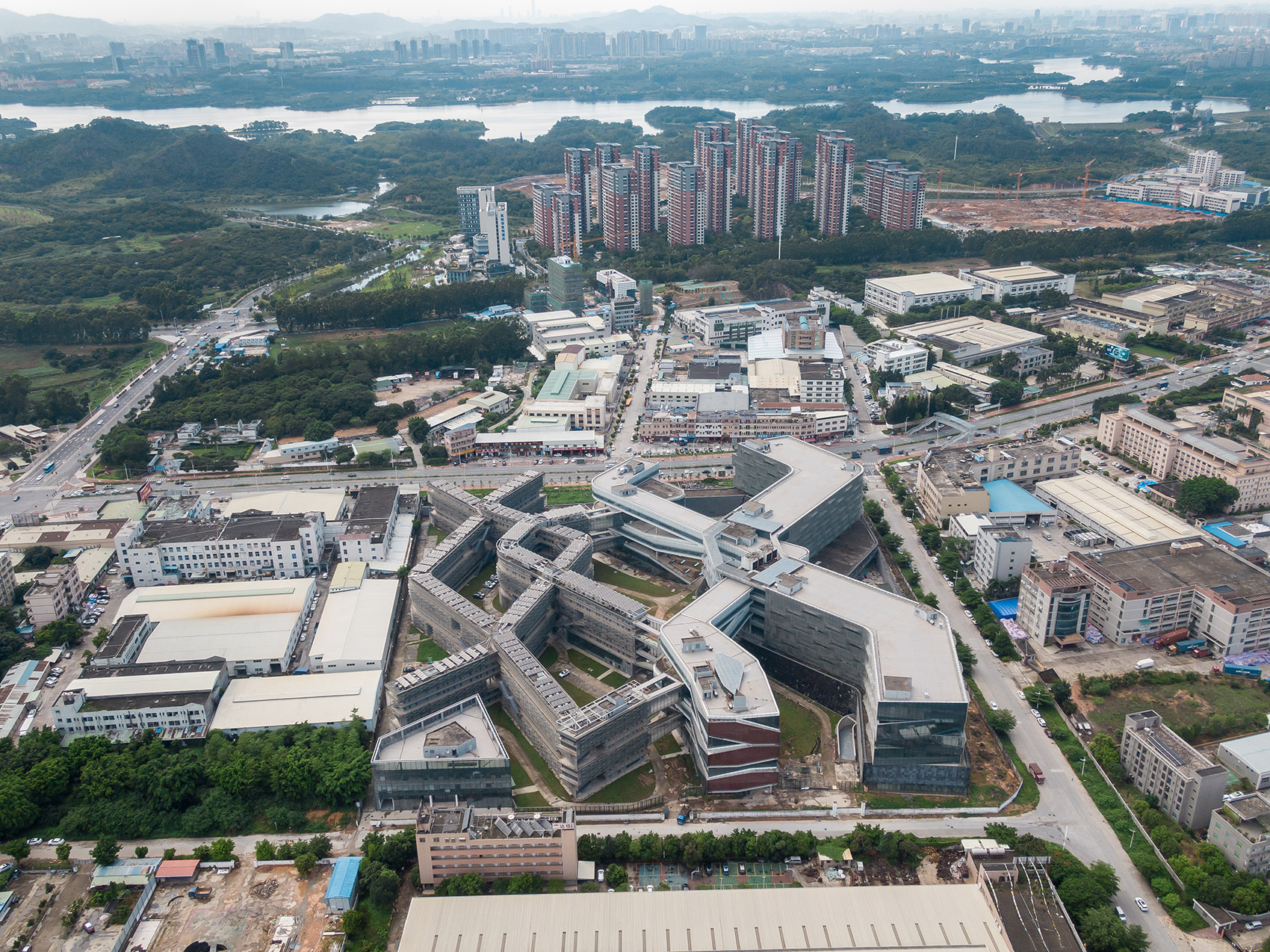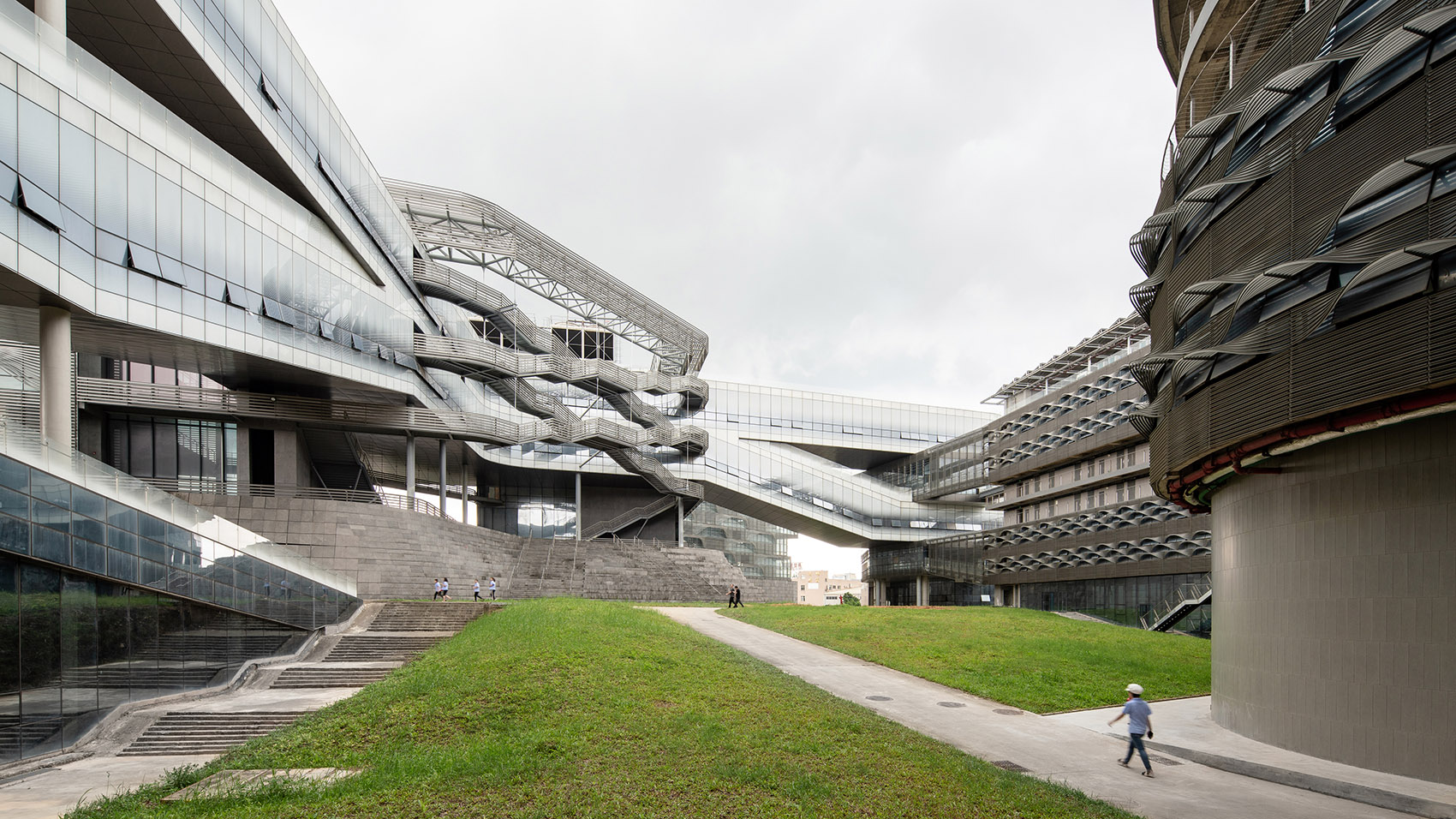迪桑娜皮具工业园坐落于广东省东莞市。在过去的几十年里,广东省快速发展,集工作与生活为一体的综合体类型的工业园也如雨后春笋般出现,为来自全国各地数以万计的务工人员提供了工作与生活的场所。在人们的印象中,工厂园区通常是远离城中心、工业化严重、缺少生活的,简单枯燥的建筑形式,造成了恶劣的生活和工作条件,限制了人与人间的互动,并最终阻碍了生产力的提高。
The Dissona Factory campus is located in an industrial sector of Guangdong province, which has experienced rapid growth over the past few decades. The urban factory campus typology, with its live-in workforce, has proliferated around the region to accommodate a large number of migrant laborers from across China. Factory campuses are typically conceived as discrete program slabs – austere buildings that foster poor living and working conditions, limit face-to-face interactions, and ultimately hinder productivity.
▼园区与周边环境鸟瞰,aerial view of the project and surrounding environment ©Chao Zhang
在这种情况下,迪桑娜公司(Dissona)希望探求一种全新的工业园模式,为员工提供优质的工作与生活环境,促进员工间的社交与凝聚力。项目由Diller Scofidio + Renfro事务所操刀,设计了一座具有开放式架构,以及抢眼的编织状外立面的综合体建筑,以容纳丰富的工作、生活、休闲等多种功能。具体的功能组成包括:办公区、工作室、展陈空间、研究室、住房、制造厂房、文化和教育设施,以及大量户外绿色空间。建筑体量之间交错重叠,创造出充满公共设施的空间节点,促进了跨阶层、跨学科之间的合作与交流。
Finding formal expression in Dissona’s desire to promote a strong sense of social cohesion, DS+R designed an open weave blanket-like structure composed of strands of diverse work and leisure programs. These strands encompass offices, studios, showrooms, research, housing, manufacturing, cultural and educational amenities, and outdoor/green spaces. The strands overlap to create nodes suffused with communal facilities, stimulating cross-pollination across hierarchies and between disciplines.
▼园区鸟瞰,aerial view of the project ©Chao Zhang
工厂生产线的设计旨在提高员工的舒适度,鼓励工作中的创新精神。开放式工作空间的天花板高达16.5英尺(约为5米),营造出宽敞通透的氛围。环绕式玻璃幕墙,辅以室内玻璃隔断和天窗系统,确保每位员工都能享有景观视野、阳光与新鲜空气。严谨的温度和湿度控制限制了玻璃的使用,因此,Diller Scofidio + Renfro事务所特别设计了一种波浪状的百叶窗系统,并将其命名为“eyelids”,该系统能够提供遮阳,改善空气流通,减少能源消耗,并赋予建筑统一的外立面表达。
The factory strands reflect a number of innovations designed to significantly improve worker comfort. Open-plan workspaces with 16.5ft high ceilings provide a generous sense of spaciousness. A wrap-around glass curtain-wall, complemented by interior glass partitions and a system of skylights, ensure that each worker is granted unobstructed access to views, natural light, and natural ventilation. Compensating for extreme temperatures and humidity, which typically limit the use of glass, DS+R created a system of undulating louvers, dubbed “eyelids,” that provide shade, improve air flow, reduce energy consumption, and give the building its unifying architectural expression.
▼交叠的建筑体量形式,Overlapping form of the architecture ©Chao Zhang
“eyelids”百叶立面延伸到生活区,这里能够为大约4000名工人提供住房。宿舍单元的空间层次循序渐进,从公共,到半公共,最终到私人空间,条理有序,反映出人性化设计。每个宿舍单元可容纳4名员工,每个私人床位都设有可自行操控的开窗,而第五扇窗则由大家共同使用,旨在增加室内的交叉通风效果。宿舍单元内的半公共空间为生活区,设有沙发、存储空间、淋浴室以及洗衣设施。这些空间延伸到公共空间中,公共空间包括:可作为阳台使用的室外走廊、穿插在宿舍单元之间的通高露天休息室等,这些空间对所有在此居住的员工开放。
The “eyelids” extend to the living strands, which provide housing for approximately 4,000 workers. The dormitory units offer a gradient of spaces – from public, to semi-public, to private. They house four workers, each of whom is granted individual control over an operable window facing private bunk alcoves. A fifth window, shared by all four residents, controls cross-ventilation. The semi-public spaces within the units include a living area with couches, storage spaces, showers, and laundry amenities. These give onto public spaces – balcony-like outdoor corridors interspersed with double-height, open-air lounges open to all live-in workers.
▼流动的建筑形式与充满绿色的公共空间,Flowing architectural forms and green filled public spaces ©Chao Zhang
文化与教育空间战略性地穿插在建筑的各个生活和工作链的节点上,这种设置堪称是该建筑对于园区内文化进步的最大贡献。设置文化与教育空间的目的旨在将新入职的员工在未来几年内培养为熟练的、全面发展的工人。为了支持这项教育规划策略,建筑中为员工们提供了教室、网吧咖啡厅,以及一处提供广泛选修课程的图书馆。文化和休闲空间则包含了一个提供全方位服务的健身房、电影院和一系列郁郁葱葱的庭院花园。此外,建筑屋顶上种植满了植物,还设有由棚架荫蔽的户外跑道。丰富的生活、工作、文化和教育空间与建筑底部的零售空间结合在一起,力求为员工与游客们创造出充满活力的城市生活氛围。
Strategically situated in the nodes where the various living and working strands of the building come together, the cultural and educational programs are perhaps the building’s most progressive contribution to industrial culture. These programs aim to transition unskilled workers into skilled, well-rounded workers within a span of several years. To support educational programming, the building provides classrooms, an internet café, and a library hosting a broad range of elective courses. Cultural and leisure spaces include a full-service gym, a movie theater, and a series of lush courtyard gardens. The building is also equipped with a rooftop running track shaded by trellises and replete with plantings. The living, working, cultural, and education programs, combined with retail operations at the building’s base, endeavor to create a dynamic city within a city for workers and visitors alike.
▼波浪状立面百叶系统,system of undulating louvers, dubbed “eyelids” ©Chao Zhang
CREDITS PARTNER-IN-CHARGE:Charles Renfro PARTNERS:Elizabeth Diller,Benjamin Gilmartin,and Ricardo Scofidio PROJECT DIRECTOR:Ling Zhang PROJECT ARCHITECT:Merica May Jensen PROJECT DESIGNER:Chris Hillyard and Merica May Jensen TEAM:Sean Gallagher,Miles Nelligan,Mian Ye,Qian Li,Alice Chai,Amber Foo,Kumar Atre,Bo Liu,Cat Lindsay,Johanna Muzbek,David Tasman,Tyler Hopf,and Ellix Wu Photography by Chao Zhang





